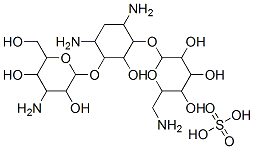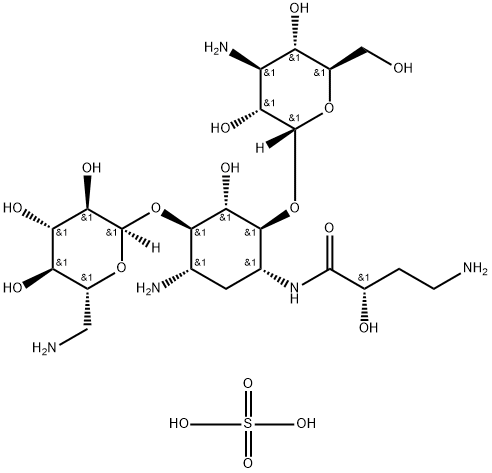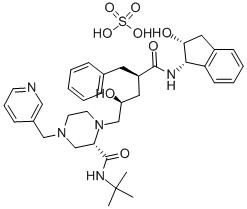KANAMYCIN SULFATE
Synonym(s):Kanamycin A;Kanamycin A sulfate salt;Kanamycin sulfate from Streptomyces kanamyceticus;Kanamycin sulfate salt
- CAS NO.:70560-51-9
- Empirical Formula: C18H38N4O15S
- Molecular Weight: 582.58
- MDL number: MFCD00070253
- EINECS: 684-844-0
- SAFETY DATA SHEET (SDS)
- Update Date: 2024-11-20 15:18:15

What is KANAMYCIN SULFATE?
Originator
Kantrex,Bristol,US,1958
The Uses of KANAMYCIN SULFATE
Kanamycin Sulfate is an aminoglycoside-antibiotic with broad antibacterial spectrum.
What are the applications of Application
Kanamycin sulfate is an aminoglycoside-antibiotic with broad antibacterial spectrum
Manufacturing Process
As described in US Patent 2,931,798, Streptomyces kanamyceticus (K2-J) was
first cultured in shake flasks in the following media: (a) 0.75% meat extract,
0.75% peptone, 0.3% NaCl, with 1.0% of starch, dextrin, maltose, glucose,
lactose, sucrose or glycerol; or (b) 2.0% soybean meal, 0.05% KCl, 0.05%
MgSO4 · 7H2O, 0.5% NaCl, 0.2% NaNO3, with 1.0% of starch, dextrin,
maltose, glucose, lactose, sucrose or glycerol. The initial pH of all media was
adjusted to 7.0. After 24 to 48 hours shaking in some cases the pH decreased
to about 6.0 to 6.8, but from 72 to 120 hours the pH rose and became 7.5 to
8.6. The production of kanamycin was apparent after 48 hours and, depending
on the media; the maximum production was found after 72 to 120 hours.
The yield was highest with starch or dextrin, intermediate and about the same
with sucrose, glucose, maltose and lactose and poorest with glycerol.
Kanamycin was produced by media containing soybean meal, peanut meal,
cottonseed meal, corn steep liquor, peptone, yeast extract or meat extract,
with or without sodium nitrate. Commercially available soybean meal was
recognized to be one of the best nitrogen sources. The addition of corn steep
liquor, peptone, yeast extract or nitrate to the soybean meal promoted the
production of kanamycin.
The brownish white kanamycin (5 g) was dissolved in 50 ml of 60% aqueous
methanol, insoluble material was removed and to the filtrate 40 ml of 60%
aqueous methanol containing 2,000 mg of ammonium sulfate was added, and
the precipitated kanamycin sulfate was collected, washed with 50 ml of 80%
aqueous methanol, and dried. Thus, 4.5 g of kanamycin sulfate was obtained
as a light brownish powder.
Therapeutic Function
Antibacterial
Clinical Use
Kanamycin Sulfate was isolated in 1957 by Umezawaand coworkers from Streptomyces kanamyceticus. Its activityagainst mycobacteria and many intestinal bacteria, aswell as several pathogens that show resistance to other antibiotics,brought a great deal of attention to this antibiotic.As a result, kanamycin was tested and released for medicaluse in a very short time.
The use of kanamycin in the United States usually is restrictedto infections of the intestinal tract (e.g., bacillarydysentery) and to systemic infections arising from Gramnegativebacilli (e.g., Klebsiella, Proteus, Enterobacter, andSerratia spp.) that have developed resistance to other antibiotics.It has also been recommended for preoperative antisepsisof the bowel. It is absorbed poorly from the intestinaltract; consequently, systemic infections must be treated byintramuscular or (for serious infections) intravenous injections.These injections are rather painful, and the concomitantuse of a local anesthetic is indicated. The use ofkanamycin in the treatment of TB has not been widely advocatedsince the discovery that mycobacteria develop resistancevery rapidly. In fact, both clinical experience andexperimental work indicate that kanamycin developscross-resistance in the tubercle bacilli with dihydrostreptomycin,viomycin, and other antitubercular drugs. Like streptomycin,kanamycin may cause decreased or complete lossof hearing. On development of such symptoms, its useshould be stopped immediately.
Properties of KANAMYCIN SULFATE
| storage temp. | 2-8°C |
| solubility | H2O: 10-50 mg/mL As a stock solution. Stock solutions should be stored at 2-8°C. Stable at 37°C for 5 days. |
| form | powder |
| color | white to off-white |
| BRN | 3874279 |
| CAS DataBase Reference | 70560-51-9(CAS DataBase Reference) |
Safety information for KANAMYCIN SULFATE
| Signal word | Danger |
| Pictogram(s) |
 Health Hazard GHS08 |
| GHS Hazard Statements |
H360:Reproductive toxicity |
| Precautionary Statement Codes |
P201:Obtain special instructions before use. P202:Do not handle until all safety precautions have been read and understood. P280:Wear protective gloves/protective clothing/eye protection/face protection. P308+P313:IF exposed or concerned: Get medical advice/attention. P405:Store locked up. P501:Dispose of contents/container to..… |
Computed Descriptors for KANAMYCIN SULFATE
KANAMYCIN SULFATE manufacturer
New Products
(S)-3-Aminobutanenitrile hydrochloride 4-Methylphenylacetic acid N-Boc-D-alaninol N-BOC-D/L-ALANINOL Tert-butyl bis(2-chloroethyl)carbamate 3-Morpholino-1-(4-nitrophenyl)-5,6-dihydropyridin- 2(1H)-one Furan-2,5-Dicarboxylic Acid Tropic acid 1-Bromo-3,5-Di-Tert-Butylbenzene S-2-CHLORO PROPIONIC ACID ETHYL ISOCYANOACETATE 2-Bromo-1,3-Bis(Dimethylamino)Trimethinium Hexafluorophosphate 4-IODO BENZOIC ACID 3-NITRO-2-METHYL ANILINE 1-(2,4-DICHLOROPHENYL) ETHANAMINE (2-Hydroxyphenyl)acetonitrile 4-Bromopyrazole 2-(Cyanocyclohexyl)acetic acid 4-methoxy-3,5-dinitropyridine 1-(4-(aminomethyl)benzyl)urea hydrochloride 2-aminopropyl benzoate hydrochloride diethyl 2-(2-((tertbutoxycarbonyl)amino) ethyl)malonate tert-butyl 4- (ureidomethyl)benzylcarbamate Ethyl-2-chloro((4-methoxyphenyl)hydrazono)acetateRelated products of tetrahydrofuran








You may like
-
 Kanamycin sulfate CAS 70560-51-9View Details
Kanamycin sulfate CAS 70560-51-9View Details
70560-51-9 -
 2033-24-1 98%View Details
2033-24-1 98%View Details
2033-24-1 -
 1975-50-4 98%View Details
1975-50-4 98%View Details
1975-50-4 -
 2-HYDROXY BENZYL ALCOHOL 98%View Details
2-HYDROXY BENZYL ALCOHOL 98%View Details
90-01-7 -
 2-Chloro-1,3-Bis(Dimethylamino)Trimethinium Hexafluorophosphate 221615-75-4 98%View Details
2-Chloro-1,3-Bis(Dimethylamino)Trimethinium Hexafluorophosphate 221615-75-4 98%View Details
221615-75-4 -
 61397-56-6 CIS BROMO BENZOATE 98%View Details
61397-56-6 CIS BROMO BENZOATE 98%View Details
61397-56-6 -
 14714-50-2 (2-Hydroxyphenyl)acetonitrile 98+View Details
14714-50-2 (2-Hydroxyphenyl)acetonitrile 98+View Details
14714-50-2 -
 118753-70-1 98+View Details
118753-70-1 98+View Details
118753-70-1